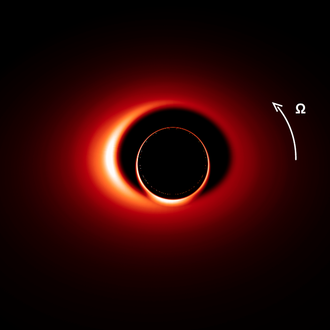
Our Galaxy contains a few systems, called black hole binaries, in which a star orbiting around a stellar-mass black hole feeds an accretion disk that surrounds the compact object. A handful of these systems show millisecond oscillations in their light curves when observed in the X-ray domain. These oscillations are very interesting because they evolve so rapidly that they are extremely likely to be related to phenomena occuring very close to the black hole, in regions where gravitational fields are exremely strong. Such oscillating systems may then be used as probes of gravity in its most extreme regime. However, before using them as probes, it is necessary to understand precisely how these oscillations are triggered. So far, no consensus has been reached and many models are proposed to account for observations.
One of these models is based on the idea that these oscillations are related to the triggering of a hydrodynamical instability in the accretion disk surrounding the black hole. This Rossby Wave Instability model was first proposed in 2006 by M. Tagger and P. Varniere. These authors have demonstrated that the Rossby Wave Instability is able to be naturaly triggered in the accretion disk of a black hole binary. As this instability evolves in a characteristic time of the order of the millisecond, it became a candidate to account for black hole binaries oscillations.
Recently, this model has been studied in more details by modeling in a realistic way the observation of such an instability in a black hole binary. In order to model such an observation, it is necessary to use a so-called ray-tracing code, that is able to follow the trajectories of photons emitted in the accretion disk all the way through the intense gravitational field of the black hole, to the distant observer on Earth. Using such a code, it is possible to compute a number of images of the accretion disk subject to the Rossby Wave Instability at different times, making a movie that shows the evolution of the instability. From such a movie it is easy to compute what astronomers will observe, that is to say the light curve, or amount of radiation received as a function of time.
This recent work (arXiv:1310.0918, "Quasi-periodic oscillations from Rossby Wave Instability", F. H. Vincent (of NCAC), P. Varniere, H. Meheut, T. Paumard, G. Torok, M. Wildner) used the open-source ray-tracing code GYOTO to demonstrate that the simulated light curves do show modulations that may account for the oscillations of black hole binaries. Such studies are interesting in particular in the framework of the next generation of instruments. If it is selected by ESO, the future (~2020) LOFT satellite will allow to observe black hole binaries oscillations with much more precision than current instruments. Accurate numerical simulations of what theoretical models predict will then be needed to try to distinguish models in the light of the future higher-precision data.
More details in:
Vincent et al., A&A, 551, A54 (2013)
Vincent et al., Proceedings of the French Astronomical Society (2013) astro-ph/1310.0918
Figure:
Ray-traced image of an accretion disk subject to the Rossby Wave Instability
as observed by a distant observer at an inclination of 45°.
Credit: Frederic Vicent (NCAC).






